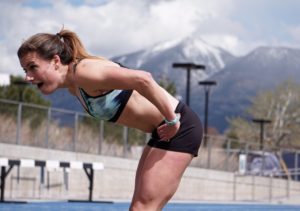 Inviting 27-year-old Jessica O’Connell to pull up a chair and talk about her training is like asking a gazelle to sit still and enjoy a cup of tea. Poised on the edge of her seat, she cannot help but look like a runner on the starting blocks. Energy is emanating from her bright brown focused eyes, and it is clear, this woman needs to move.
Inviting 27-year-old Jessica O’Connell to pull up a chair and talk about her training is like asking a gazelle to sit still and enjoy a cup of tea. Poised on the edge of her seat, she cannot help but look like a runner on the starting blocks. Energy is emanating from her bright brown focused eyes, and it is clear, this woman needs to move.
At 5’2” and barely more than 100 pounds, O’Connell is the world’s 22nd fastest female runner in the 5,000-meter race. She came to Flagstaff from Calgary for the second year in a row because she wants to be faster. It is here, at 7,000 feet, that her body ramps up its red blood cell production, satiates itself with oxygen and propels her deeper into the field of Olympic hopefuls. Last summer, her high altitude training resulted in a personal best. She shaved seven seconds off her time and trainers say that is huge in a sport where fractions matter.
“Oh, I felt amazing,” she said. “I nailed a race immediately coming out of the camp. And then my workouts for weeks after were the best I’ve ever done.”
This summer, O’Connell wants more. As she pounded out her 80-mile-a-week workouts in Flagstaff, facilitated by Athletics Canada’s relationship with HYPO2 high altitude training camp, she also participated in the largest ever international high altitude-nutrition combination study of elite athletes to learn how she can tweak her training, nutrition and energy stores for maximum performance.
Largest Altitude Study on Athletes
O’Connell, along with nearly 50 other world-class athletes, had her blood drawn at the beginning and end of the intensive three-week training. She kept a record of everything she ate, had her bones scanned for strength and density at Northern Arizona Orthopedics and documented all treatments like chiropractic, physical therapy and deep muscle massage, as well as injuries and illnesses over the previous year.
“Altitude is a stress on the body,” said Canadian exercise physiologist Trent Stellingwerff, Ph.D., a scientist involved in the research. “It needs to be managed properly. Some athletes might overdo it, over-train a little bit and then actually be over-fatigued and maybe not race as well. We do a lot of monitoring while we’re up here. Every morning, athletes give a heart rate, oxygen saturation and body weight. I’m constantly looking at how athletes are doing and feeling to make sure we don’t over-train them while they’re up here. They are certainly working hard, there’s no question about that, but it’s a fine line between pushing them to the limit versus having them fall off a cliff.”
Stellingwerff is looking specifically at four key research areas. “One is the impact of iron on red blood cell production. The second would be the impact of energy balance, what you consume versus what you’re using during training. Another is the impact on bone mineral density and injury and illness rate. And, a fourth is the impact of training load because we’re also assessing how much people train or don’t train and what that does on red blood cells.”
Researchers are analyzing everything in the athletes’ diets, asking questions like: Are they meeting their nutritional requirements? Are they carbohydrate sufficient? Are they getting enough protein throughout the day? What about their micronutrients? Could they be deficient in calcium?
With this information, exercise physiology doctorate student Ida Heikura from the University of Jyväskylä, Finland, generated a 10-page report for each participating athlete. The timing of the findings was expected to be particularly helpful, just two months before qualifying races leading into the 2016 Summer Olympics.
“I noticed a couple of mineral and vitamin deficiencies that I had no idea about before,” said O’Connell. “Vitamin E, for example, I was only getting about 15 percent of my RDA, which was shocking to me, because I think I eat a normal, well-balanced diet. So I’ll definitely look into things like that to try to make up any gaps that I have.”
“Some athletes think a gap is bad,” said Stellingwerff. “I’m like, ‘No, it’s a gift!’ That’s something that we can work on. Maybe an athlete has borderline low iron. Well, great! That’s a gap. We can address that, go to the pharmacy and get an iron supplement. We might find something like an athlete chronically over one week of dietary recording was at a 20 percent deficit. They might not even know that. They might be totally not conscious of it, but they have a history of getting ill often or having injuries often. If we can correct that and they can get a little bit more out of each training while they are up here, or as they leave from here, train with a little more quality because they have a little better energy and nutrition, that may go a long way in the next couple of months.”
HYPO2 Involved in Research
Sean Anthony has been operating HYPO2 since 2009 to provide altitude-based high performance services and access to high quality training facilities to all levels of athletes who want to improve their performance, with a special focus on elite endurance athletes.
“What we have in Flagstaff is truly unique and special. When you think about it, look how many people get excited about one Olympic athlete training in their community; for example, U.S. swimmer Michael Phelps training at ASU. In Flagstaff, we’re accommodating scores of world-class athletes all the time. For the 2012 Olympics, we had 155 competitors from 18 countries who trained here and competed in London. There are few places anywhere in the world that do what we do.”
Anthony and HYPO2’s sport physiologist Dan Bergland were involved in setting up testing for the high altitude-nutrition study, which was approved by the University of Helsinki’s ethics committee.
“Sean and his team have really been up here a long time. Their ability on the ground is invaluable,” said Stellingwerff. “We identified an athlete who has super low iron in this study to the point that we actually wanted to do an intervention, medically. So Sean said, ‘No problem.’ He immediately linked us up with one of HYPO2’s medical partners to sort it out. They know exactly where to go for everything, and provide so much support and logistics on the ground.”
Anthony says HYPO2 has a $1.1 million economic impact on Coconino County according to the Arizona Rural Policy Institute. “This study will have a global reach and open the door for HYPO2 to be more proactive in research. We will not just be a place to facilitate high altitude training, but also engaged in research and driving the sports industry in terms of where altitude training is going in the future.”
Some of the same principles that improve an athlete’s performance on the track can be applied to increase a business executive’s success in the workplace, he says, which is an area of expansion for HYPO2. “That’s one of the next frontiers.”
Sleep Impacts Performance, Health
Although sleep was not specifically measured and part of the altitude-nutrition study, Stellingwerff says one area of the altitude study that may benefit everyone is understanding more about the value of sleep.
“I think lack of sleep is going to be the new smoking,” said Stellingwerff. “A lot of people talk about the fountain of youth, what the fountain youth is, if I were to summarize it in just a couple of things, it would be sleep, moderate exercise and a moderate, well-balanced diet. But sleep is massive. And I think as we learn more and more about it and more research comes out, I believe lack of sleep will become the new smoking in terms of long-term health. Obesity rates are correlated to lack of sleep, diabetes is correlated to lack of sleep. There’s a lot of health implications with poor sleep.”
“As athletes, we put so much into our training and we do what we’re told in terms of our runs and our work-out sessions, but having concrete data behind those things makes us much more willing to do it and to buy in and to believe that that is truly making a difference,” said O’Connell. “We have so many things thrown at us – training, physio recovery, nutrition – and it gets to be overwhelming at times. We all want to be the best that we can be and by knowing that this is making a true difference, then we 100 percent buy in.”
O’Connell’s best time in the 5,000-meter race (3.2 miles) is 15 minutes and six seconds. She says reducing her time to 15 minutes flat in the qualifying races this month should get her to the Rio de Janeiro finals in August.
She can be sure, Stellingwerff and Anthony will be among those watching every step. FBN
By Bonnie Stevens, FBN
Photo caption:
Fueled by Flagstaff’s mountain air, Canada’s Jessica O’Connell is hoping high altitude training and findings from an international study on elite athletes puts her on track for Rio.
Photo courtesy Samantha Murphy







